Just like every living creature, trees have their own immune system. This indicates that, much like humans, trees are prone to different kinds of diseases.
Here are some of the most common tree diseases, along with their respective treatments.
What we cover
ToggleAnthracnose disease
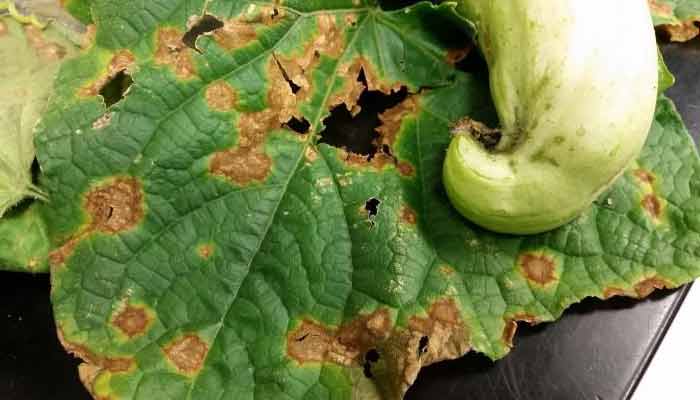
Anthracnose is a fairly common fungus1 that can affect trees that are in particularly damp environments or have a generous amount of foliage. The foliage makes it easier for the fungus to grow in the shade/ dark and to camouflage itself. Anthracnose has a direct effect on the leaves of a tree.
It will appear as brown or yellow spots often resulting in small holes forming in the leaves where the spot appears. It can cause stunted growth of your tree and reduced fruit or vegetable production in cultivated edibles. It can also cause leaf defoliation in your plants.
Treatment
The treatment for Anthracnose is easy if you spot it early enough. For this purpose, you will have to locate the infected part of the foliage and cut it off. As mentioned, Anthracnose thrives in damp and dense foliage.
Another important step towards prevention is to ensure that your trees are planted at a suitable distance from one another and trees are trimmed regularly so good light can penetrate the tree’s canopy and in turn, it also allows a healthy amount of airflow between the trees, keeping them dry for the most part.
Apple Scab disease
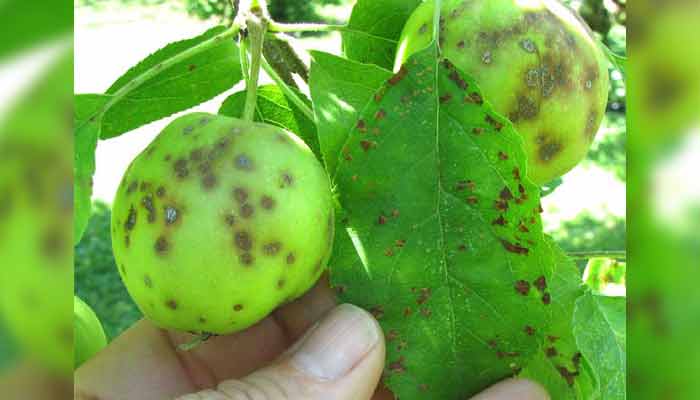
Apple Scab2 mainly affects Crabapple trees. It is primarily a leaf disease as opposed to a tree disease. Some native species may be more resilient to this disease as compared to others, however once infected on the leaves it can spread to the fruit as well as lead to leaf defoliation.
Treatment
Use a fungicide that contains the active ingredient Fenarimol. There is no need to remove the infected leaves as the fungicide will kill the fungus to restore your leaves and tree to their former glory. You will need to remove and dispose carefully of infected fruit.
Cedar Rusts disease
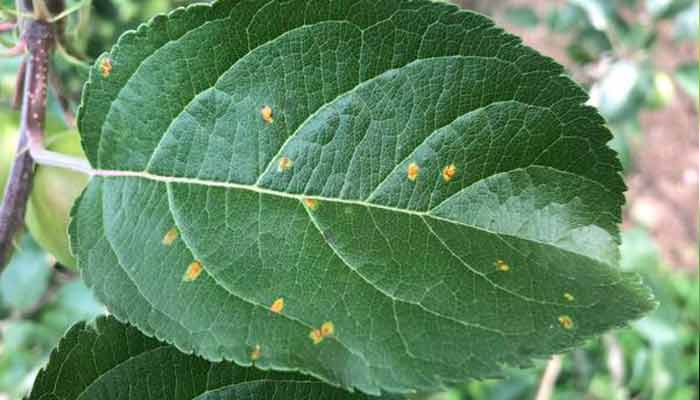
Cedar rusting is also commonly known as Cedar apple rust3 and is found on most rosaceous plant varieties. You will often find it categorized under ‘foliar’ tree diseases. Similar to apple scab, some species of rosaceous plants may prove more immune than others.
This disease causes leaves to turn orange or form rust-colored spots on the surface. It can also lead to the formation of pores on juniper branches. In more severe cases, it can cause the development of twig cankers and lead to dieback.
Treatment
Similar to Apple scab, cedar rusts can be controlled with the use of fungicide. The fungicide can be applied once the leaves start changing color or develop rust-like abrasions.
Emerald Ash Borer
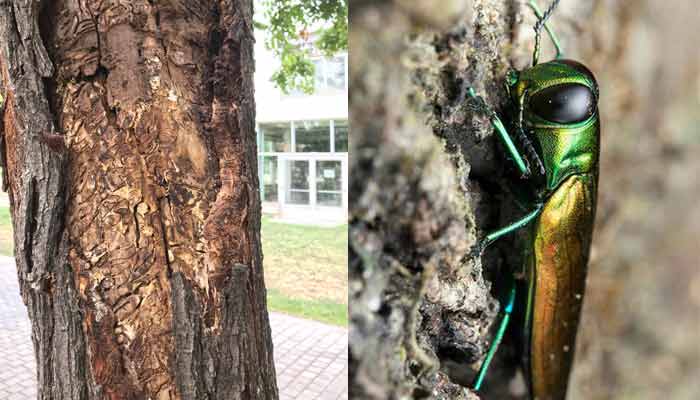
If you notice the leaves on your trees turning yellow during the offseason, then your tree has most likely fallen prey to the beetle, Emerald Ash Borer. The beetle works like that of a termite. It makes its way through the wood by making tunnels and infects the tree from within. The yellowing leaves are a common symptom that will probably be followed by the branches of the tree dying.
If left untreated for too long the borer will kill your tree as when it borrows it actually cuts off the tree’s ability to feed itself. If you are lucky it will only affect one side of the tree, but if the borer makes its way all the way around the tree, then there is no going back. Your tree will most certainly die.
Treatment
To treat a tree infested with Emerald ash borer or more specifically to kill the beetle, you need to use an insecticide that can be injected directly into the trunk of the tree or sprayed on the bark as a general application. This does not guarantee that the infection is completely removed. You may kill the beetle, but the new larva is waiting to hatch. You will need to treat the tree several times over 6 weeks and hope for the best.
In some extreme cases, the best course of action is to trim affected branches or remove the tree altogether. For information on the cost of tree removal or the price to trim your tree, check out our cost guides.
Cypress Canker
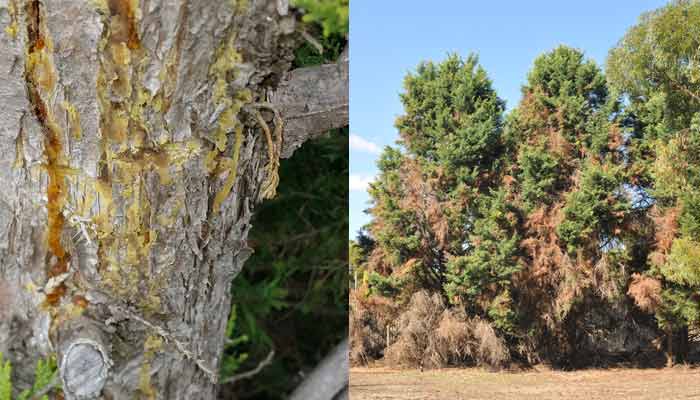
Cypress Canker is a tree disease most commonly found in Australia, but also in certain parts of the United States. These Cankers4 happen because of an infection that is easily spread as it can be carried over by the wind, water as well and certain pruning tools.
An infected tree will most likely have red branches that are bound to die out quickly, sometimes even within a day. This can also cause the branches to turn yellow with a buildup of fungus over them.
Treatment
There is no way to prevent this infection as of yet. However, you can cut down the affected branches to prevent them from spreading throughout the tree. If the entire tree has been infected, then cut down the whole tree and plant a non-cypress tree in its place so that it is not susceptible to the same infection.
Oak Wilt
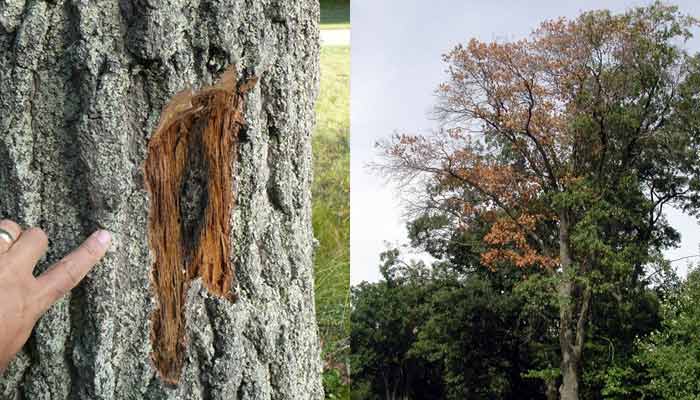
Oak Wilt is another disease that is specific to Oak trees. It stems from a fungus and is typically passed on from the roots of one oak tree to another, but can also be carried by beetles. This makes it a little easier to detect and control. Trees affected by Oak Wilt will have rust-colored leaves in the off-season along with having an overall cracked and wilted look.
Treatment
To prevent the spread of Oak Wilt, you can dig up some soil around the infected tree and use some pruning tools and materials to block the passage of the fungus from the soil onto the next oak tree. If you have a large plantation of Oak trees it would be advisable to just remove the oak tree altogether and kill the stump and roots. This will guarantee the fungus will not spread.
Root Rot
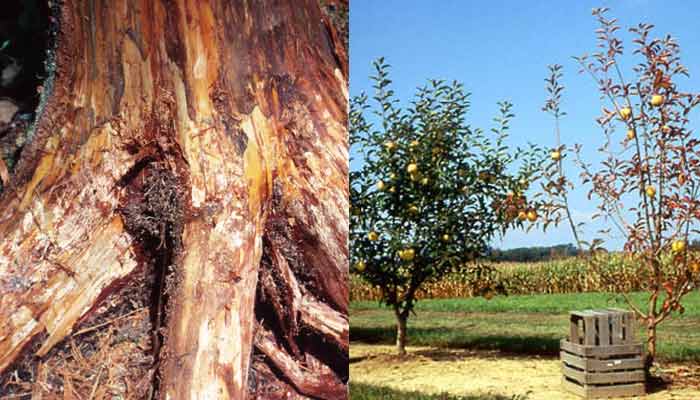
Evident by the name, Root Rot is a disease that affects the roots of a tree, causing the tree to have pale leaves and a wilted appearance even in the spring/summer season. Root rot is easier to control because it does not spread naturally. This is because of this particular fungus present in the soil. Therefore, if a tree has been infected, the surrounding trees may remain unaffected because there is little to no trace of the fungus in the surrounding soil.
This can be dangerous as if left untreated for long periods of time, the tree’s roots will decay making it unstable.
Treatment
You can contact a professional to help you with this problem. The treatment process typically consists of isolating the infected tree by digging up the earth around the tree and pruning it properly. This should help remove the fungus and protect the surrounding trees from the risk of infection.
Citrus Gall Wasp
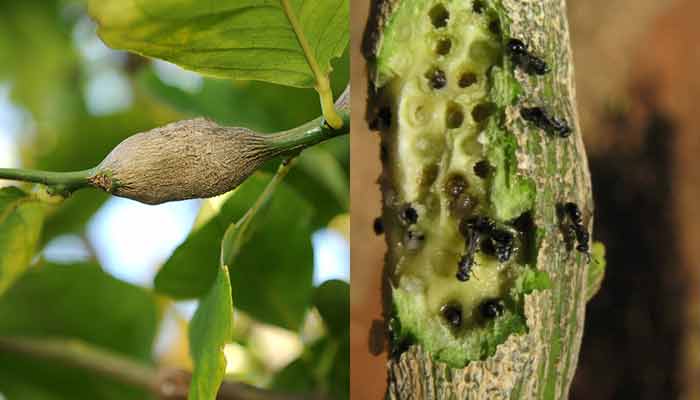
If you observe the branches of your citrus tree and it appears to be swelling, the tree has likely been infected by a citrus gall wasp. The wasp typically lays its eggs within the branches of the citrus tree. These eggs cause an infection within the tree, and the cycle continues as more wasps are born and more eggs are laid.
Treatment
The best way to get rid of this infection is to remove the infected branches. It is recommended that you do this as soon as you notice any swollen or inflamed branches to prevent the infection from spreading to other parts of the tree. There are no such sprays yet that can keep away citrus gall wasps. Therefore, you will have to be vigilant, and if you notice the issue address it by removing the affected branch.
Powdery Mildew
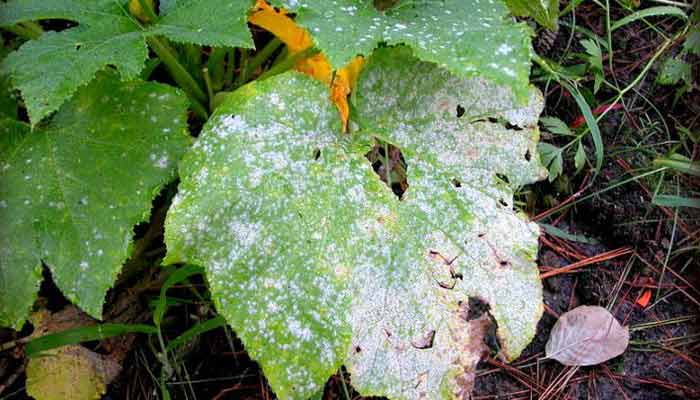
Unlike some of the other diseases on this list, powdery mildew can typically be caused by several different fungal pathogens working together. This mildew primarily consists of ‘fungal threads’ that are formed on the surface of the plant. These threads or ‘hairs’ are also referred to as white mycelia. The fungi usually target younger plant tissues and cause stunted growth of the leaf along with distortion of the stem/trunk.
Treatment
To prevent powdery mildew, try to plant your trees with suitable spacing in between to promote good airflow and make sure they have access to plenty of sunlight. You can also opt to use a fungicide to reduce the risk of infection.
Photinia Leaf Spot
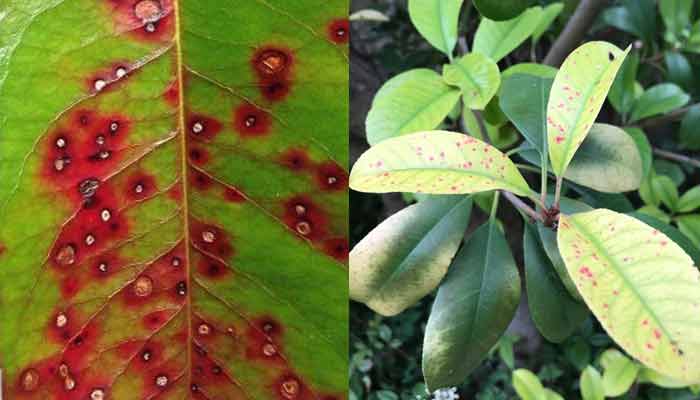
Photinia Leaf Spot is a disease found in several species of trees. Once again, this is caused by a fungus, and early symptoms include the formation of unsightly red spots on the surface of the tree leaves. As the infection progresses, the spots become gray in the center and red on the outside.
Treatment
As was the case with powdery mildew, you can start by removing the affected areas (if isolated) and spraying the rest of the plant with a fungicide. If the whole plant or tree is infected, give it a good prune of 25% and spray it with a fungicide.
Ash Dieback
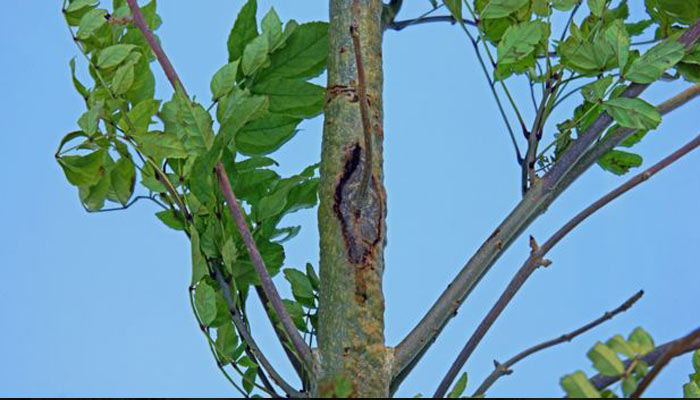
As evident by the name, Ash Dieback is typically a disease that is common with Ash trees. It is caused by a fungal infection that goes by the name of Chalara Fraxinea, or C. Fraxinea for short. This disease primarily causes the tree to shed its leaves, with visible lesions in the stem that look like a burn, and crown dieback. In extreme cases, this will cause the tree to die altogether.
This is a relatively new type of infection; the very first cases of trees affected by C. Fraxinea were recorded in the year 2012. Although it is believed that the infection has been imported from some other parts of the world, the disease is more likely to be spread through natural means, i.e., spores carried out in the wind from one area of a forest to another.
Treatment
The best way to prevent this fungal infection from killing your whole tree is to keep watch over your ash trees. If you do spot it, you are best getting a tree-cutting service near you to remove the affected branches or parts of the tree. Keep the environment around the tree and the tree itself clean. Disinfect your equipment regularly to prevent the spread of the infection. Familiarizing yourself with all the symptoms of Ash Dieback will help you catch the infection early on if it has affected your tree, and you can start working on the treatment as soon as possible to avoid further damage.
Sudden Oak Death
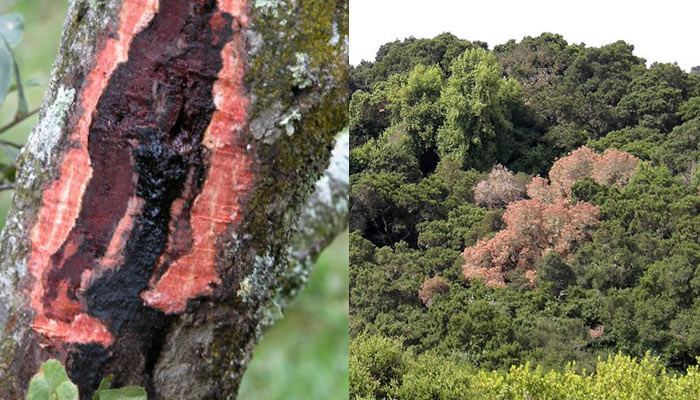
Sudden Oak Death has mostly affected tree plantations in the United States as well as some regions of Europe, including Britain. It has been observed that the culprit is often the fungus Phytophthora ramorum, but it seems that native oak trees in Europe are relatively immune to this disease as compared to American Oaks.
It has been known to affect forests and plantations in bulk all across Europe; however, the outbreak has since been controlled.
Treatment
Once this fungus takes hold the death of your oak tree is usually pretty swift. Because of that reason, there is generally no way of treating your tree. If your tree does die, it is advisable that you remove your dead tree as it becomes unstable quite quickly.
Red Band Needle Blight
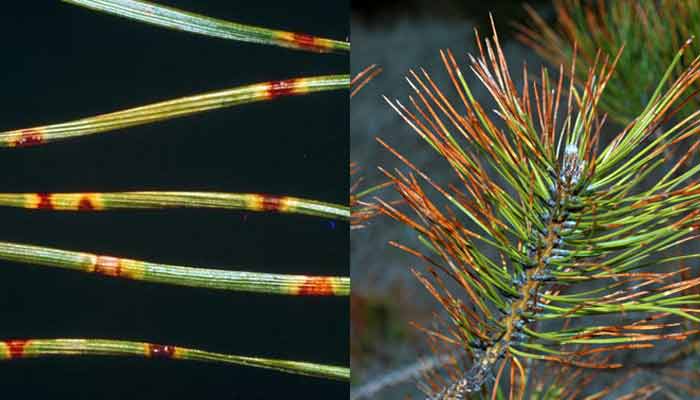
Red Band Needle Blight can cause needle defoliation in trees. In extreme cases, this may lead to tree death as well. This disease, in particular, has spread very quickly in Europe. This can be attributed to changing climatic conditions, i.e., increased rainfall and prolonged warm spells in the summer then spring gives rise to infections and allows them to spread more easily.
Treatment
There are several causes for the origin and spread of such diseases, however, in most cases, it’s a fungus. Spraying a fungicide on affected areas should do the trick or removing the affected branches altogether will also work.
Viral/Bacterial Sources
Bacteria or Viral infections tend to affect trees when the tree has undergone a pest infestation or some significant weather damage. This leaves the tree vulnerable to being attacked by viruses and bacteria. Trees generally decline at different paces. These can be defined broadly under two categories, i.e., acute and chronic decline.
The acute decline means that the tree is decaying at a relatively faster rate while chronic decay may be stretched over a long period. You can tell if a tree is decaying by looking at the foliage and observing the leaves. If the foliage is deteriorating and the leaves are growing smaller than usual, then the tree is most likely decaying. The color of the leaves and the trunk is also a good indicator of this.
Fungal sources
There are two primary types of fungal infections, namely white rot, and brown rot.
White rot tends to attack all the parts of the tree trunk. It causes the tree to become soft and spongy, in addition to making it lose its color. On the other hand, brown rot attacks two primary layers, namely the cellulose and hemicelluloses.
This leaves only the lignin intact. The trunk and branches start decaying, and the tree adopts a brown and cracked appearance. This indicates that the tree has lost most of its structural integrity and is seriously brittle.
More resources
If you can not find the cause of your tree issues, here, I suggest you visit our homepage, where were have many other articles on tree maintenance, including why a tree might be dying and how to save it.
- treesforlife, (2014) fungi-95. <https://treesforlife.org.uk/into-the-forest/habitats-and-ecology/ecology/fungi-95/> Accessed: 21-02-2024
- Kari A. Peter, (2023) Apple Disease – Apple Scab. <https://extension.psu.edu/apple-disease-apple-scab> Accessed: 21-02-2024
- Rebecca Koetter and Michelle Grabowski, (2019) Cedar-apple rust and related rust diseases. <https://extension.umn.edu/plant-diseases/cedar-apple-rust> Accessed: 21-02-2024
- Michelle Grabowski and Cynthia Ash Kanner, (2018) Cytospora canker. <https://extension.umn.edu/plant-diseases/cytospora-canker> Accessed: 21-02-2024




